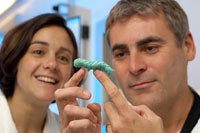Scientists from the Universities of Bath and Exeter have developed a rapid new way of checking for toxic genes in disease-causing bacteria which infect insects and humans. Their findings could in the future lead to new vaccines and anti-bacterial drugs.
They studied a bacterium called Photorhabdus asymbiotica, which normally infects and kills insects, but which can also cause an unpleasant infection in humans.
By testing groups of genes from the bacteria against three types of invertebrates (insects, worms and amoebae) and mammalian cells, the scientists were able to identify toxins and other molecules, called virulence factors, made by the bacteria that allow it to infect each type of organism.

By pinning down the genes responsible for each of these possible virulence factors and comparing them with the genes of well known bacteria, the scientists have been able to map out which regions of the bacteria’s DNA control its ability to infect and damage invertebrates, and also potentially humans.
Dr Nick Waterfield from the University of Bath’s Department of Biology & Biochemistry said: “Many bacteria have evolved to infect one particular type of plant or animal and most of the toxins they use to do this also have an effect in other hosts.
“Some of the toxins they use for infecting can also allow the bacteria to jump across into another species like humans, perhaps with fatal consequences.”
Dr Maria Sanchez-Contreras, who works with Dr Waterfield at the University of Bath said: “We have developed a new way of discovering a greater number of previously unknown toxins and measuring how dangerous or virulent these bacteria are. Identifying the genes responsible for the production and secretion of these bacterial toxins will allow us find ways to prevent disease.
“Our new technique, called Rapid Virulence Annotation (RVA), allows us to make faster assessments of the disease-causing agents in multiple types of organism; it lets us pinpoint sequences of genes which may pose a risk to humans; and it gives us a powerful tool to identify virulence genes in other known bacteria.
“Finally, it helps us identify new targets for drugs to fight these diseases and control pests, and for developing preventive vaccines.”
Richard ffrench-Constant, Professor of insect microbiology from the University of Exeter’s Cornwall Campus adds: “RVA allows us to look for virulence factors that are totally novel and does not rely upon traditional searches based on factors already known from other bacteria. We have already discovered that some totally unexpected genes are indeed involved in bacterial virulence. This technique should prove to be a gold mine for potential vaccine candidates.”
The scientists are already using this relatively cheap and highly accurate RVA technique in other disease-causing bacteria to identify the genes which allow some diseases to jump the species barrier.
Article: Waterfield NR, Sanchez-Contreras M, Eleftherianos I, Dowling A, Wilkinson P, Parkhill J, Thomson N, Reynolds SE, Bode HB, Dorus S, Ffrench-Constant RH, Rapid Virulence Annotation (RVA): Identification of virulence factors using a bacterial genome library and multiple invertebrate hosts, doi: 10.1073/pnas.0711114105




Comments